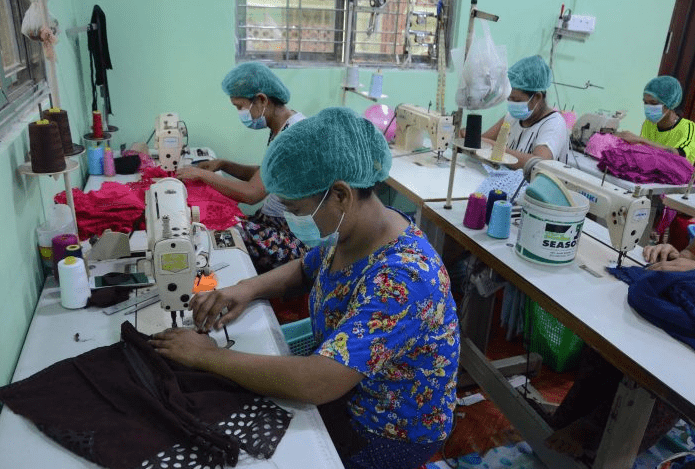Manufacturing production grows 10% annually in Myanmar

Myanmar‘s manufacturing sector has grown at nearly 10% annually since 2013, the World Trade Organization (WTO) reported on Monday.
In part, this dynamism is due to the reform of the Myanmar Investment Law in 2016.
The main subsectors are food and beverages, and textiles and clothing.
Myanmar is a least developed country (LDC).
Strong growth since their reintegration into the world economy has led to a reduction in poverty and inequality.
To illustrate, the Gross Domestic Product (GDP) per capita has risen to more than $ 1,300.
The services sector, which contributes the most to GDP, accounted for 40.7% of this in fiscal year 2018/2019, followed by manufacturing (24.8%) and agriculture, forestry and fishing (21.3%).
Manufacturing
To date, Myanmar has developed a relatively large manufacturing sector, which has recorded an annual growth of almost 10% (24.8% of GDP in fiscal 2018/2019, compared to 19.9% in fiscal 2013/2014).
On the one hand, the main manufacturing subsectors are the food and beverage industry and the textile and clothing industry.
On the other hand, the average MFN tariff applied to non-agricultural products has been 6.6% in 2020, with a range of 0 to 40 percent.
The Ministry of Planning, Finance and Industry (MOPFI) is responsible for industrial policy.
A new industrial policy targeting 10 industries was enacted in 2016, focusing on creating a favorable business environment, human resource development, technological upgrading, expanding markets and privatizing those industries.
The policy was revised in 2020 taking into account, among other aspects, recent economic developments and the National Export Strategy.
Thus, the number of priority industries has been reduced to three: food processing, textiles and machinery.
Government
The support measures are aimed at:
- Prepare a declaration of rights for investors.
- Design an investment plan in state-owned companies.
- Establish an index of manufacturing production.
- Carry out a normalization.
- Get acquainted with the fourth industrial revolution.
- Adopt energy efficiency and conservation measures and the preservation of the environment.
- Promote corporate social responsibility.
According to the authorities, one of the main reforms to boost investment in the manufacturing sector was the adoption of the Myanmar Investment Law of 2016.
Foreign investment in the manufacturing sector increased 17.8% in fiscal year 2017/2018, and domestic investment increased by 409% in 2017/2018 (compared to fiscal year 2014/2015).
Also, the Policy for the Development of SMEs, 2015; the Law on the Development of SMEs, 2016; and the Regulation for the Development of SMEs, of 2017, were enacted with the aim of promoting the manufacturing sector.
Composition by products of merchandise trade, by main HS sections, 2013 and 2019


Under Myanmar’s Investment Law 2016, FDI is only allowed in the form of a joint venture for the production or distribution of certain food products (such as cereal-based products and confectionery); drinks and mineral water; and soap, cosmetics, and certain chemicals.
Incentives
In accordance with the MIC Classification of Promoted Sectors (Notification No. 13/2017), some investments in the manufacturing sector may benefit from an exemption from income tax.
Several state-owned companies operate in the manufacturing sector (textiles, paper and consumer goods, food products, pharmaceuticals and heavy industry):
- Heavy Industry Company No. 1: light and heavy motor vehicles, passenger cars, trucks, auto parts, diesel engines; agricultural machinery and equipment; equipment for excavations and construction; and steel ingots and pig iron.
- Heavy Industry Company No. 2: household appliances; machines; PVC cables; electric cables; transformers, turbines and generators, LEDs; tires; Portland cement; brick and ceramic pieces; and float glass.
- Heavy Industry Company No. 3: textiles, clothing and accessories; high quality paper pulp and paper; and hydrogen peroxide.
- Myanmar Pharmaceutical Industry Company: various kinds of pharmaceuticals, sugar, soap and plastic shopping bags.
Manufacturing and clothing sector
This Myanmar industry has grown rapidly in recent years, with manufacturers being paid by foreign contractors for cutting, making and packing operations and exporting finished products.
Inputs for garment production are provided by buyers, with the majority imported into Myanmar from China, India, the Republic of Korea and Thailand.
The garment industry in Myanmar employs about 450,000 workers, and in 2018 generated around $ 2.7 billion in export earnings.
![]()

